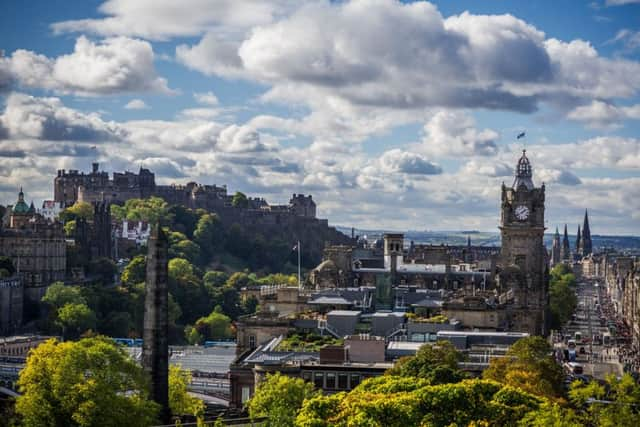Surging Edinburgh tourism may make city '˜hollow city-museum shell'


Experts have claimed that “commercial over-exploitation” of the city centre is posing a serious threat to the “authenticity” of the Edinburgh World Heritage site.
They say the historic heart of the city is under growing pressure due to the opening of new hotels, a growth in the holiday flats market, mounting pressure on residents and record numbers at visitor attractions.
Advertisement
Hide AdAdvertisement
Hide AdThe Edinburgh World Heritage trust, which has pledged to try to influence a change in direction in the way the city is managed, has even drawn comparisons with Venice, describing it as a “hollow city-museum shell”, and urging action to ensure the city does not suffer “the same fate”.


The charity, which has called for a greater balance to be struck between the needs of visitors, residents and local businesses, said there was a pressing need for work to be done to “understand the capacity limits of our fragile, historic city”.
The body is urging the city council to consider a range of measures to limit the impact of the city’s booming tourism industry in the city centre.
These include more stringent licensing controls, new curbs on “street noise” late at night, better waste management and the provision of more affordable housing.


Amsterdam, Barcelona, Berlin and Rome are among the cities which have faced growing demands to curb the number of visitors, while the authorities in Venice recently backed new measures, including imposing new limits at the most popular attractions and encouraging visits to less-crowded areas.
A clampdown in Edinburgh has been urged following years of expansion in the sector to try to meet an industry target of boosting the number of visitors by a third by 2020.
Edinburgh has seen visitor numbers soar by more than half a million in the past five years to 3.85 million. Visitor spending has also soared over the same period, from £1.01 billion to £1.31 billion.
Advertisement
Hide AdAdvertisement
Hide AdThe value of wages and salaries of more than 30,000 tourism workers employed in the city is now said to be worth around £400 million each year.
Latest figures show the growth of tourism in Edinburgh has been faster than the rate in both Scotland and the UK, with a 33 per cent rise in domestic visitors and a 27 per cent increase from foreign tourists in five years.
An additional 1400 new rooms have been created in the space of five years thanks to the development of 10 new hotels. However another 2000 more rooms are said to be in the pipeline.
The Edinburgh Tourism Action Group (ETAG) wants to attract another £400 million in visitor spending by attracting more Chinese tourists, boosting visits from January to March, and luring visitors away from the Old Town. Other key elements include attracting new events and festivals to the city, and improving transport links, including the tram network.
However Edinburgh World Heritage claims economic development has favoured the tourism economy over local residents, with the care and maintenance of historic buildings neglected while poor quality or inappropriate hotel projects are pushed through against the wishes of existing home owners.
Nicholas Hotham, head of external relations at the heritage body, said: “Edinburgh is the UK’s second most important tourist destination and receives around four million visitors a year, who generate £1.3 billion for the economy. This is because the city is simply one of the most attractive destinations in the world, with an ideal mix of culture, music, shopping, heritage and leisure facilities.
“Hotel occupancy is high, and the growth of the short-term holiday lets sector has been exponential in the past five years. Visitor attractions are also reporting record increases in numbers and are near capacity, while residents in the Old Town are under increasing pressure from the visitor economy. Does this mean the city is now full?
Advertisement
Hide AdAdvertisement
Hide Ad“Venice receives over 20 million visitors a year, and has become a hollow city-museum shell. If we are to avoid the same fate, we need to balance the needs of visitors, residents and businesses to ensure the city continues to thrive. We must seek to understand the capacity limits of our fragile, historic city.
“While tourism is clearly an engine of economic growth, consistent feedback from residents indicates that the needs of the visitor economy must be balanced against the needs of residents, especially in the Old Town.
"This could take the form of more stringent licensing controls, restrictions on short term holiday lets, control of street noise late in the evenings, better waste management and the provision of more affordable housing.
"Commercial over-exploitation of the city’s historic environment represents a threat to the authenticity of the site and, in the long term, will damage visitor appeal.”
The latest ETAG strategy, published in September, has called for the industry, which currently supports more than 30,000 jobs, to be “even more ambitious” by 2020.
It states: “Tourism is an important part of the way the city works more generally and in improving the quality of life. Everyone benefits from the services that it enables.”
However ETAG admits the growing popularity of both the Old and New Towns was “creating increasing challenges due to the density of visitors during peak times.
Advertisement
Hide AdAdvertisement
Hide AdIts strategy warns: “There is a danger this will start to impact on the quality of the visitor experience and create friction between local residents and the tourism sector, as well as limiting potential growth. Extending the footprint has the power to increase the length of stays and encourage more repeat visits. This involves providing more things to see and do and raising awareness of these among visitors.”
John Donnelly, director of Marketing Edinburgh, said: “There are certain cities which are currently being over-stretched by tourism, including Berlin, Barcelona and Venice.
"Tourism has taken over the soul of these cities, but I don’t think we are anywhere near here. Tourism, businesses and residents need to exist in harmony and I think that broadly happens in Edinburgh.
“In Amsterdam they’ve made a real effort to move people around the city and I think that’s what we should be looking at in Edinburgh, with places like Leith or Stockbridge. However we also have to remember that the majority of visitors come to Edinburgh because it is a historic city.”
A spokeswoman for the city council said: “Our world heritage site is of crucial importance to the future vision and development of the city.
"Along with Edinburgh World Heritage and Historic Environment Scotland, we’re currently reviewing all of the responses to the consultation for the new management plan for the site, which is due to be agreed later this year.”
Manuela Calchini, regional director at VisitScotland, said: “Every year, Edinburgh’s stunning beauty, vibrant atmosphere and fascinating heritage attracts millions of visitors from around the world. The ripple effect of the visitor economy means that these visits don’t just benefit tourism businesses, but the city as a whole.
Advertisement
Hide AdAdvertisement
Hide Ad“We’re delighted to see a number of new hotel developments are in the pipeline, further boosting capacity, but we appreciate that ensuring the industry remains sustainable requires a sensitive approach.
“We’re committed to working closely with partners to identify appropriate infrastructure requirements and ensure Edinburgh remains a must-visit destination for future generations of holidaymakers.”
